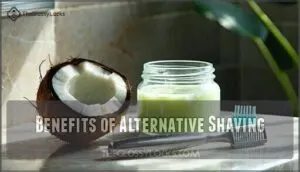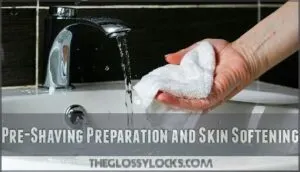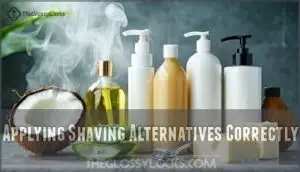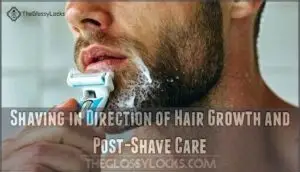This site is supported by our readers. We may earn a commission, at no cost to you, if you purchase through links.
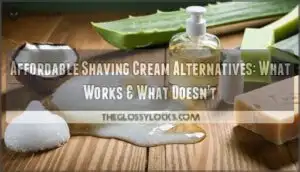
Coconut oil provides excellent lubrication for under $3, while hair conditioner creates smooth glides at fraction of traditional cream costs.
Olive oil works well but can feel heavy, and aloe vera gel soothes sensitive skin perfectly.
Soap bars offer convenience but may cause dryness.
Baby oil delivers slick surfaces though cleanup takes longer.
Each alternative cuts costs by 60-80% compared to premium creams costing $8-15.
Your skin type determines which works best, and some unexpected household items outperform expensive brands in both comfort and results.
Table Of Contents
- Key Takeaways
- Shaving Cream Alternatives
- Benefits of Alternative Shaving
- Choosing Right Shaving Alternative
- Shaving Cream Substitute Risks
- Effective Shaving Techniques
- Frequently Asked Questions (FAQs)
- What is the best alternative of a shaving cream?
- What is the difference between cheap and expensive shaving cream?
- Can I use vaseline as shaving cream?
- Is it okay to use lotion as shaving cream?
- How often should you replace razor blades?
- Can shaving alternatives cause razor clog issues?
- Which alternatives work best for electric razors?
- Do homemade shaving mixtures expire or spoil?
- How much alternative product per shave session?
- Conclusion
Key Takeaways
- You’ll cut costs by 60-80% using household items like coconut oil ($3), hair conditioner, or aloe vera gel instead of premium creams that cost $8-15.
- Your skin type determines what works best – oily/acne-prone skin needs non-comedogenic options like aloe vera, while dry skin benefits from moisturizing alternatives like conditioner or shea butter.
- You’ll get better results with proper technique – apply thin layers on damp skin, shave with the grain, and always patch test new alternatives 24-72 hours before full use.
- Some alternatives can backfire – thick oils may clog pores and razors, while certain ingredients cause allergic reactions, so avoid coconut oil if you’re acne-prone and skip anything with fragrances for sensitive skin.
Shaving Cream Alternatives
Running out of shaving cream doesn’t mean you’re stuck with a rough, irritating shave.
You’ve got plenty of household alternatives that can protect your skin and help your razor glide smoothly, from coconut oil to hair conditioner.
Natural Ingredients and Benefits
Several natural ingredients work as effective shaving cream alternatives.
Coconut oil provides fatty-acid-rich hydration while protecting skin from razor tugging.
Aloe vera gel soothes irritation with anti-inflammatory properties, helping blades glide smoothly.
Shea butter nourishes dry skin with its creamy texture.
Plant-based oils like olive oil contain vitamins and antioxidants.
These natural moisturizers create protective barriers, reducing friction and razor burn.
Coconut Oil and Aloe Vera Properties
Coconut oil benefits include creating a slick surface that reduces razor friction while its medium-chain fatty acids soften hair for easier cutting.
Coconut oil transforms tough stubble into butter-soft hair while your razor glides like silk across protected skin.
Aloe vera hydration penetrates deeply, providing moisture to multiple skin layers. Both natural moisturizers offer anti-inflammatory effects, with coconut oil’s lauric acid and aloe vera’s phytosterols soothing irritated skin.
These moisturizing properties make them excellent for sensitive skin use. Combining these ingredients can enhance skin elasticity, promoting a more youthful appearance with improved skin elasticity.
Cost-Effective Options for Shaving
Your wallet doesn’t need to suffer for smooth shaves.
Many household items work as cheap shaving cream alternatives, delivering DIY shaving solutions without breaking the bank.
These multi-use products offer long-term savings:
- Hair conditioner – creates slick surface, costs pennies per use
- Body lotion – moisturizes while protecting from nicks
- Baby oil – prevents razor drag, lasts months
- Olive oil – kitchen staple with antioxidant benefits
- Body wash – foams like traditional cream, already in your shower
Budget ingredients beat expensive alternatives every time.
Benefits of Alternative Shaving
When you ditch traditional shaving cream, you’re not just saving money – you’re often treating your skin better too.
Most household alternatives like coconut oil and aloe vera create that essential barrier between your razor and skin while delivering extra moisturizing benefits that regular shaving cream can’t match.
Reduced Friction and Irritation
Alternative shaving methods create a protective barrier that dramatically reduces friction between your blade and skin.
This barrier prevents razor burn, minimizes skin irritation, and helps your razor glide smoothly across the surface.
You’ll notice fewer nicks and cuts when using proper substitutes, especially if you shave frequently.
The improved blade glide means less tugging on hair follicles, reducing your risk of developing painful ingrown hairs and addressing skin sensitivity concerns effectively, which can be achieved through proper substitutes.
Hydration and Skin Protection
Your skin craves moisture during shaving, and moisturizing shaving cream alternatives deliver essential skin hydration.
These barrier repair solutions create protective layers that lock in moisture while you shave.
Anti-inflammatory ingredients in natural alternatives soothe sensitive skin and prevent irritation.
Alternative humectants like aloe vera provide ongoing skin protection throughout your routine.
Proper shaving lubrication maintains hydration levels, supporting healthy post-shave care.
Some users find coconut oil benefits their skin.
Eco-Friendly and Convenient Options
Choosing ecofriendly shaving alternatives helps you reduce waste while protecting your skin.
Many sustainable ingredients like coconut oil and aloe vera come with minimal packaging, eliminating plastic aerosol cans that contribute to landfill pollution.
- Refillable options like shaving bars last 6-12 months, cutting costs and waste
- DIY recipes using household items create waterless shaving solutions instantly
- Natural shaving cream alternatives support cruelty-free, ethical sourcing practices
Switching to eco-friendly products reduces plastic waste from razors and packaging.
Choosing Right Shaving Alternative
Selecting the right shaving cream alternative depends on your skin type and specific needs.
Consider sensitive skin and allergies when choosing between natural options like aloe vera or heavier alternatives like coconut oil.
Skin Type and Specific Needs
Understanding your skin type transforms your shaving experience from risky to remarkable.
Know your skin, nail your shave—it’s that simple.
Oily skin and acne concerns require non-comedogenic alternatives like aloe vera, avoiding coconut oil that clogs pores.
Dry skin thrives with moisturizing conditioner or shea butter.
Sensitive areas need fragrance-free options, while allergy-prone individuals should patch-test before committing to any substitute.
For ideal results, consider natural oil options to enhance the shaving process.
Considering Sensitive Skin and Allergies
When you have sensitive skin shaving or known allergies, irritant-free options become your best friends.
Hypoallergenic shaving alternatives like pure aloe vera gel or fragrance-free coconut oil won’t trigger unwanted skin reactions.
Here’s your sensitive skin prep checklist:
- Allergy patch-test any new product on your inner wrist 72 hours before shaving
- Choose dermatologist-approved substitutes without added fragrances or harsh chemicals
- Start with minimal amounts to gauge your skin sensitivity before full application
Avoiding reactions means reading ingredient lists carefully and sticking with products you know work well for your unique skin needs.
Shaving Cream Substitute Risks
While shaving cream alternatives can save money and work effectively, they aren’t risk-free for everyone.
Some substitutes may cause allergic reactions, clog pores, or create a messy shaving experience that defeats the purpose of convenience, leading to a potentially messy situation.
Potential Skin Reactions and Allergies
Allergic reactions can sneak up on you when trying new shaving alternatives.
Ingredient sensitivities affect 3-7% of users with natural oils, while aloe vera allergic reactions occur in 0.1-1% of people.
Patch testing on your inner elbow prevents unwanted surprises.
Always check product ingredients for common allergens like fragrances before switching from traditional shaving cream.
| Alternative | Common Reaction Rate | Key Allergen Risk |
|---|---|---|
| Coconut Oil | 3-7.2% users | Nut allergies, comedogenic |
| Aloe Vera | 0.1-1% population | Cross-reactivity with Liliaceae plants |
| Fragranced Products | Variable | BHT, synthetic fragrances |
| DIY Alternatives | Unknown | Lack ingredient transparency |
Watch for irritation symptoms like redness, swelling, or burning.
Hypoallergenic options reduce skin sensitivity risks, but patch test everything first.
Stop immediately if allergic dermatitis develops.
Clogged Pores and Acne-Prone Skin
For those with acne-prone skin, certain shaving alternatives can spell trouble.
Comedogenic ingredients in coconut oil and olive oil may trigger oil buildup, leading to clogged skin pores and unwanted breakouts.
These comedogenic oils sit heavy on your face, blocking natural exfoliation methods your skin needs.
Skip these pore-clogging culprits and choose non-comedogenic alternatives for better acne prevention and pore minimizing results.
To manage acne after shaving, consider applying tea tree oil to reduce inflammation.
Messy and Ineffective Alternatives
Some kitchen staples create more problems than they solve when shaving without cream.
While creative, these household items often leave you dealing with cleanup headaches rather than smooth skin.
Here are five messy alternatives to avoid:
- Honey messiness – Creates sticky application that’s nearly impossible to rinse clean
- Peanut butter – Leaves greasy residue and clogs razor blades completely
- Avocado concerns – Chunks stick to skin and create uneven protection
- Soap dryness – Strips natural oils, leaving skin tight and irritated
- Water risks – Plain water increases nicks and razor burn substantially
Effective Shaving Techniques
Once you’ve chosen your alternative, proper technique makes all the difference between a smooth shave and potential skin damage.
Following the right steps guarantees you’ll get the best results while protecting your skin from irritation and cuts, which is crucial for a smooth shave.
Pre-Shaving Preparation and Skin Softening
Take time to prep your skin before reaching for shaving cream alternatives.
Soak the area for fifteen minutes with warm water or apply a warm compress to achieve proper skin hydration and hair softening.
A key step is to cleanse skin thoroughly before shaving, which reveals exfoliation benefits while creating the perfect foundation for affordable shaving options to work effectively, and helps achieve proper skin hydration.
Applying Shaving Alternatives Correctly
Mastering application amount guarantees the best razor glide when using shaving cream alternatives.
For oils, spread a thin layer across damp skin—too much creates slippery conditions. Lotions and gels need sufficient coverage without rubbing in completely, maintaining that protective barrier.
Soap requires proper lathering with a sponge for smooth gliding. Consider shaving oil products for enhanced lubrication.
Always perform patch testing before trying new affordable shaving options to ensure the best shaving experience.
Shaving in Direction of Hair Growth and Post-Shave Care
When you shave with the grain, you’ll cut irritation risks by over 70% and prevent most razor bumps.
For a smoother experience, consider products for this method.
Rinse your blade frequently during shaving to maintain clean cuts.
After shaving, splash cold water to close pores, then apply fragrance-free moisturizer immediately.
This shaving routine with proper aftershave prevents razor burn and maintains healthy skin between sessions.
Frequently Asked Questions (FAQs)
What is the best alternative of a shaving cream?
Who knew that razor burn could be solved by raiding your kitchen cabinet?
Hair conditioner stands out as the best shaving cream alternative—it’s affordable, readily available, and provides excellent lubrication while moisturizing your skin effectively.
What is the difference between cheap and expensive shaving cream?
Expensive shaving creams contain premium ingredients like vitamin E, aloe vera, shea butter, and wheat germ for better skin protection.
While cheaper options focus on basic lubrication without specialized moisturizing benefits.
Can I use vaseline as shaving cream?
You can use Vaseline as shaving cream, but it’s not ideal.
While petroleum jelly creates a protective barrier and prevents razor burn, it’s thick, messy, and may clog pores on sensitive skin.
Is it okay to use lotion as shaving cream?
Yes, you can definitely use lotion as shaving cream!
Body lotion creates a protective barrier that helps your razor glide smoothly while moisturizing your skin.
It’s particularly effective for softening hair and preventing irritation during shaving.
How often should you replace razor blades?
Dull blades can turn your morning routine into a torture session.
Replace your razor blades every 5-7 shaves or when you notice tugging, increased irritation, or multiple passes needed for smoothness.
Can shaving alternatives cause razor clog issues?
Thick oils like coconut oil can clog your razor’s blades, while heavier creams and butters may build up between the blade edges, requiring more frequent rinsing during shaving.
Which alternatives work best for electric razors?
Unlike traditional wet shaving‘s smooth sailing, electric razors need dry conditions.
Skip oils, lotions, and gels—they’ll gum up your razor’s mechanics.
You’ll want completely dry skin for ideal performance and blade longevity.
Do homemade shaving mixtures expire or spoil?
Homemade shaving mixtures definitely expire since they lack preservatives that commercial products contain.
Oil-based mixtures spoil within weeks, while fresh ingredients like honey or aloe deteriorate quickly, potentially causing skin irritation.
How much alternative product per shave session?
Less is more when measuring shaving alternatives—you’ll need just a quarter-teaspoon of oil, a dime-sized amount of lotion, or enough gel to create a thin protective layer over your skin.
Conclusion
Like finding a treasure map in your pantry, affordable shaving cream alternatives comparison opens doors to budget-friendly grooming solutions.
You’ll discover coconut oil, aloe vera, and hair conditioner deliver superior results while slashing costs by 60-80%.
Your skin type determines which works best—oily skin thrives with lightweight options, while dry skin benefits from moisturizing alternatives.
Test carefully, watch for reactions, and you’ll find effective substitutes that outperform expensive creams without breaking the bank, leading to budget-friendly solutions.
- https://us.dollarshaveclub.com/blogs/club-chronicles/shaving-cream-alternatives-for-when-you-ve-run-out-of-lather
- https://www.ulike.com/blogs/hair-removal/shaving-cream-alternatives
- https://www.manscaped.com/blogs/grooming/shaving-cream-substitutes-that-actually-work
- https://spongelle.com/blogs/news/our-9-tips-for-how-to-shave-without-shaving-cream
- https://www.theidearoom.net/diy-shaving-cream-2/

